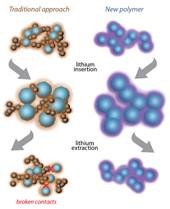Creating Bright Ideas for Lasting Innovations
 Image courtesy of Lawrence Berkeley National Laboratory
Image courtesy of Lawrence Berkeley National Laboratory
At left, the traditional approach to composite anodes using silicon (blue spheres) for higher energy capacity has a polymer binder such as PVDF (light brown) plus added particles of carbon to conduct electricity (dark brown spheres). Silicon swells and shrinks while acquiring and releasing lithium ions, and repeated swelling and shrinking eventually break contacts among the conducting carbon particles. At right, the new Berkeley Lab polymer (purple) is itself conductive and continues to bind tightly to the silicon particles despite repeated swelling and shrinking.
Teams at two of the Energy Department's laboratories are making headway on two projects that will enable building a new lithium battery that charges faster, lasts longer, runs more safely, and might also arrive on the market in the not-too-distant future. Lithium batteries are used in a variety of everyday products from laptops to cell phones, but an improved battery could also significantly increase the charge capacity of hybrid electric vehicles, and energy storage systems of wind and solar power generators.
Researchers at Oak Ridge National Laboratory (ORNL) and Lawrence Berkeley National Laboratory (Berkeley Lab) focused on a key battery component, the anode, where electricity comes out. Most current commercial lithium batteries have anodes made of graphite, a form of carbon. However, scientists at ORNL incorporated a special form of the compound titanium dioxide into the anode instead, and they found significant improvements. At the same level of current, it takes the new ORNL battery just six minutes to be 50 percent charged, while a graphite-based lithium-ion battery would see a mere 10 percent increase in the same timeframe. The new ORNL battery also outperforms faster-charging lithium titanate batteries (which use tiny particles of lithium titanate in the anode in place of graphite to speed charging) and, unlike such batteries, has a sloping discharge voltage that is good for controlling the state of charge.
ORNL's new battery has the potential to be used in a wide range of heavy-duty applications, especially places where increased strength and safety are at a premium such as hybrid electric vehicles, power grids and the energy storage systems of wind and solar power generators. Additional research needs to be performed, but scientists at ORNL believe that if titanium dioxide proves scalable in batteries, they could be on the market within five years.
Berkeley Lab researchers are taking a different approach. They designed a new anode made from a tailored polymer—a material made of millions of repeating units—that conducts electricity. It also embeds silicon particles, which in turn bind to a lot of lithium ions (much more than graphite anodes can). These improvements give the battery a much greater capacity—the ability to store much more energy—than current designs. Even better, they maintain that increased capacity after hundreds of charge-discharge cycles.
The better anode built by Berkeley Lab could contribute to lowering the cost and extending the range of electric cars. Researchers say the anode can be built at a comparatively low cost, and in a way that's already compatible with established manufacturing technologies. And they offer that the tailored polymer that makes the battery better could see use in a wide range of other products too.
Thanks to the Energy Department-supported research, bright ideas are becoming better batteries…and hopefully, a brilliant future.
The research at ORNL was supported by the Energy Department's Office of Science and ORNL's Laboratory Directed Research and Development program. The research at Berkeley Lab was supported by Department's Office of Energy Efficiency and Renewable Energy, with additional research and facilities support from the Energy Department's Office of Science.
Charles Rousseaux is a Senior Writer in the Office of Science.


